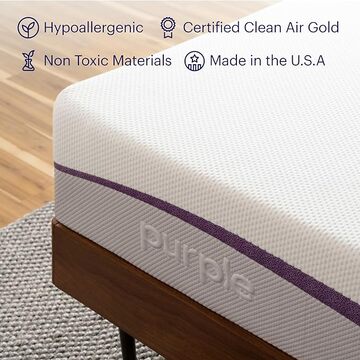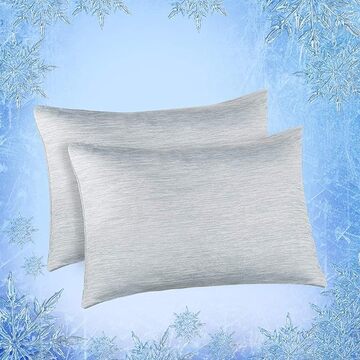13 potential night sweats causes
The most common causes for night sweats and waking up drenched at night are:
- Environment: temperature too high in the bedroom, too much beddings, etc.
- Diet/ Lifestyle: caffeine, alcohol, spicy food, or tobacco can increase your temperature. Exercising or having hot drinks before bedtime can too.
- Anxiety/Stress
- Medication Side Effects
- Periods: your temperature may rise a few days before and during your periods
- Menopause: also known as ‘hot flashes’ during the day
- Pregnancy
But night sweats can also be a sign of an underlying condition:
- Chronic Sweating: Hyperhidrosis is a condition in which you produce too much sweat, no matter the temperature or time of the day
- Infections
- Cancers
- Hypoglycemia
- Hormone Disorder
- Neurological conditions
(source)
Most of the time, night sweats are normal and nothing to worry about and they can be addressed with the tips below. However, night sweats could also be a sign of an underlying condition.
You should get concerned about night sweats if you suffer from unexplainable night sweats constantly, even after you tried a bunch of tricks, including the below. If that’s your case, please be sure to contact your doctor for medical advice. Better safe than sorry!
19 tips for dealing with night sweats
Tip 1: Keep your room cool and ventilated
Keep your bedroom door open to let the air flow through the room, and open the windows if it helps. A standing fan will help move the air through even further, and the little breeze will be a relief. If you don’t want to use a standing fan, you can try a clip-fan that you clip on your night-stand so it blows air right on your face.
According to sleep experts, the ideal temperature for a good night’s sleep is around 65° Fahrenheit (or 18° Celsius). So if you don’t want to wake up drenched at night, try it out, and then adjust the temperature up or down over the next few days until you find the right temperature for you.
Tip 2: Pay attention to your diet and lifestyle
If you are a hot sleeper, you’ll want to limit your consumption of alcohol, caffeine, spicy foods, and tobacco because these increase the body temperature.
You’ll also want to avoid having hot drinks at night, but keep cold water by your side in case you get hot.
You may also want to exercise early in the day instead of in the evening.
Tip 3: Keep cold water on your nightstand
When you get night sweats, you loose a lot of water and may wake up feeling thirsty, so make sure you stay hydrated and keep water by your side. To keep it cool all night, use an insulated water bottle instead of a glass.
Tip 4: Reduce stress and anxiety
We’ve all woken up drenched in sweat at night in the middle of a nightmare. Stress and anxiety will make you sweat more at night, so make sure you establish a calming routine before bedtime. For example, you can try reading a book or listening to relaxing music before bedtime instead of watching TV/checking your phone. Make sure you dim the lights.
Meditation is also a great way to reduce stress before going to bed. Make sure that you will at least only breathe for 10 minutes if not more. Breathe in, Breathe out!
Tip 5: Wear breathable pajamas
Hot sleepers should pick pajamas that are loose fitting and made of lightweight fabrics. You can try Cool-Jams moisture-wicking pajamas for both men and women to stay cool. Natural fabrics such as cotton and bamboo are also great because they are breathable. Check out the simple designs of Latuza Bamboo pajamas. If you are waking up drenched at night and you hate seeing sweat stains on your PJ’s, make sure you pick your Pajamas in the right colors to hide sweat. Opt for black, white, or patterns pajamas since they won’t show sweat stains as much.
Tip 6: Use layers for your beddings
The easiest way to regulate your temperature is to be able to add or remove layers. So instead of using a comforter, you may want to use a flat sheet and one or two blankets. That way, if you’re having night sweats you can easily remove one or two blankets and sleep with only a flat sheet (or nothing!).
Tip 7: Choose lightweight blankets
Avoid fleece, down, synthetic, or weighted blankets/comforters because these will make you sweat at night. Go for breathable cotton blankets instead. A waffle weave cotton blanket is super lightweight and breathable (it’s also called a “hospital style blanket”). It’s super easy to wash in your washing machine. That’s what I’ve got, and it’s perfect in the summer. If it’s too hot I remove it and only keep the flay sheet, and if it’s too cold, I add a little throw blanket on top, and voila! Just play with the layers!
Tip 8: Try leakproof underwear
If you’re having night sweats, chances are your bottoms will be wet too. And there is nothing more annoying than being in wet underwear. So you can try wearing leakproof underwear to help absorb the sweat down there.
Tip 9: Avoid running electronics in your bedroom
If you have a TV, a computer, a wifi box, and more things like that in your bedroom, they will for sure make your room warmer and you are likely to wake up drenched at night. So avoid having these in your bedroom if you can, or make sure you completely turn them off a few hours before bedtime ( ‘sleep mode’ only is not sufficient).
Tip 10: Pay attention to your mattress
Foam mattresses limit the airflow and will make you sweat more at night. So if you’re a hot sleeper and are thinking of switching mattresses, you may want to consider an innerspring mattress with a cotton cover, or a latex hybrid mattress since these can help with airflow (Check out the Cooling Gel Foam Mattress by Zinus or Free Air Flow mattress by Purple).
Tip 11: Use a mattress protector
If you are not planning to change your mattress, then getting a breathable mattress protector is a must to both absorb the extra sweat and protect your mattress from yellow stains caused by night sweats. When you do get one tough, make sure it’s mainly cotton and bamboo, and has as little polyester as possible because polyester/plastic mattress protectors would make you sweat more actually!
Tip 12: Get a cooling pillow
When your head gets too hot, you can always flip the pillow on the other, cooler side. But this only works up to a certain point. When that trick stops being enough, you’ll want to consider switching from your classic pillow to a memory foam, gel or latex pillow instead. The Coop Home Goods Pillow is made of gel-infused memory foam and microfiber to regulate temperature. The Beckham Luxury Linens Pillow in gel memory foam is also breathable for all seasons.
Tip 13: Switch to a cooling pillowcase
In addition to changing pillow, you can also try using a cooling pillowcase that has a comfy side for the winter and a cooling side for summer nights. The Elegear cooling pillowcase has a double-sided design, on one side is made with Japanese Arc-Chill cooling sensing technology fabric, silky and cool, perfect for summer; while the other side is 100% cotton fabric.
Tip 14: Change your sheets regularly
When you sleep, you leave dead skins, hairs, body oils, and sweat on your sheets. So bacteria build up, and you may become scratchy or get health issues. So make sure you change your sheets regularly. The Sleep Foundation recommends changing sheets once a week. You can change them more often if you wake up drenched at night.
Tip 15: Get moisture absorbing sheets
If you can only change one thing in your bedroom, it has to be the sheets. Not all sheets are creating equal, and if you’re a hot sleeper, you want to make sure you pick sheets that allow air to circulate and wick sweat away. You can go for moisture-wicking sheets, or bamboo sheets (since bamboo naturally wicks moisture away), or 100% cotton sheets. Make sure you pick sheets with cooling technology or with natural fabrics because they are more effective than synthetic fabrics in managing body temperatures.
Tip 16: Keep a handkerchief on your nightstand
When you wake up drenched at night, or your head is wet in sweat, you don’t want to use your pajamas or sheets to absorb the sweat, so keep some handkerchiefs on your nightstand to tap your face during the night as needed. You don’t want to use Kleenex as these would tear once wet.
Tip 17: Use a knee pillow if you’re a side sleeper
If you’re a side sleeper like me, you may get joint pain in your knees over time, and you may be sweating a lot between your legs. To prevent that from happening, place a pillow between your legs. A knee pillow will help keep your spine straight, and will let your legs breathe!
Tip 18: Keep a cooling spay mist on your nightstand
If you wake up drenched at night, first absorb the sweat with your handkerchief and then use a Peppermint cooling spray mist , or a hot flash cooling mist, or a simple Evian mineral spray to keep your face hydrated.
Tip 19: Apply a cooling lotion and balm right before bed
Applying some peppermint lotion or a menthol balm before bed will give you that cold tingle before bedtime so you can fall asleep more easily.
Conclusion
Waking up drenched at night is definitely uncomfortable and it disrupts your sleep. In most cases, that’s nothing serious and is just due to the room temperature, the weather, etc. But sometimes, night sweats can be caused by an underlying condition that requires treatment. So if they happen no matter what you try, make sure you speak to your doctor about it to find out the cause of your night sweats. Depending on the underlying problem, they might recommend lifestyle changes, medications, or other treatments.
















